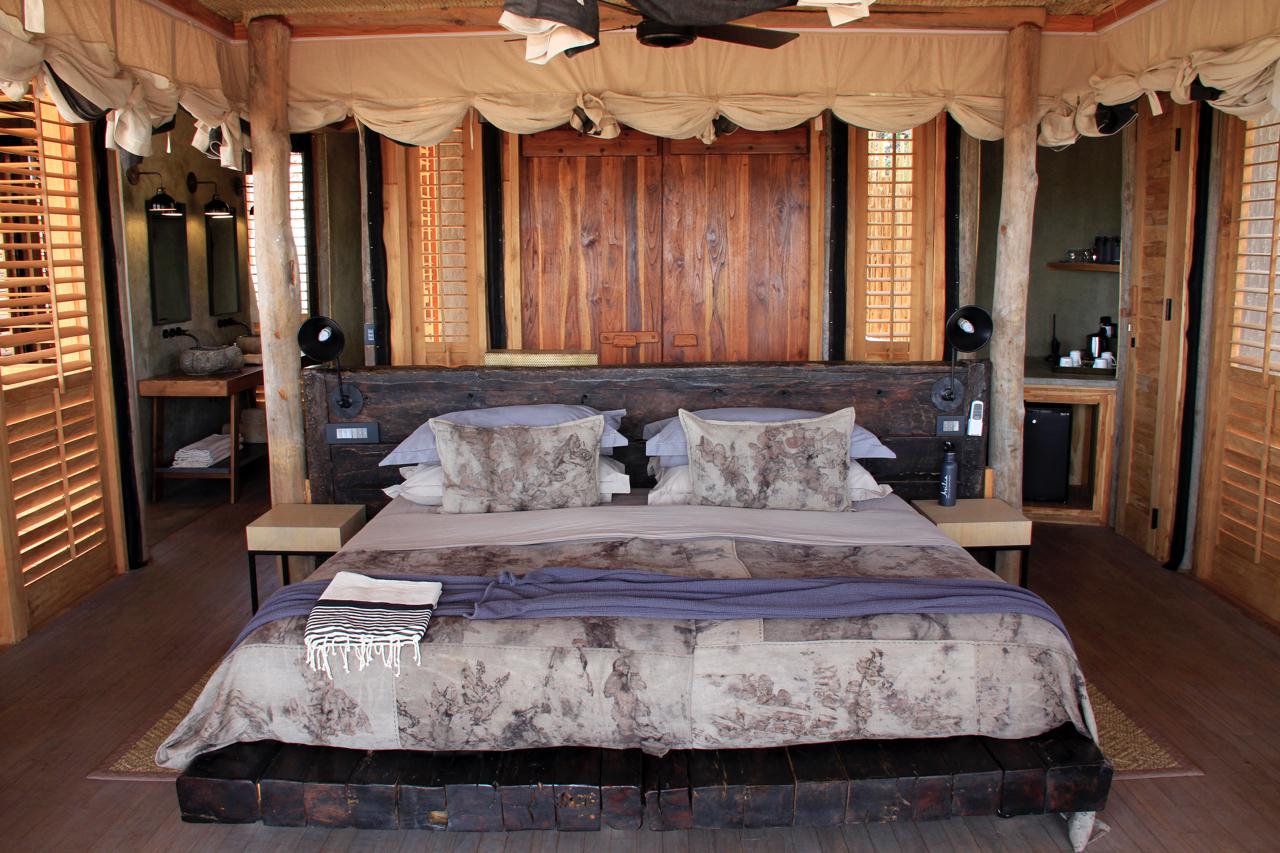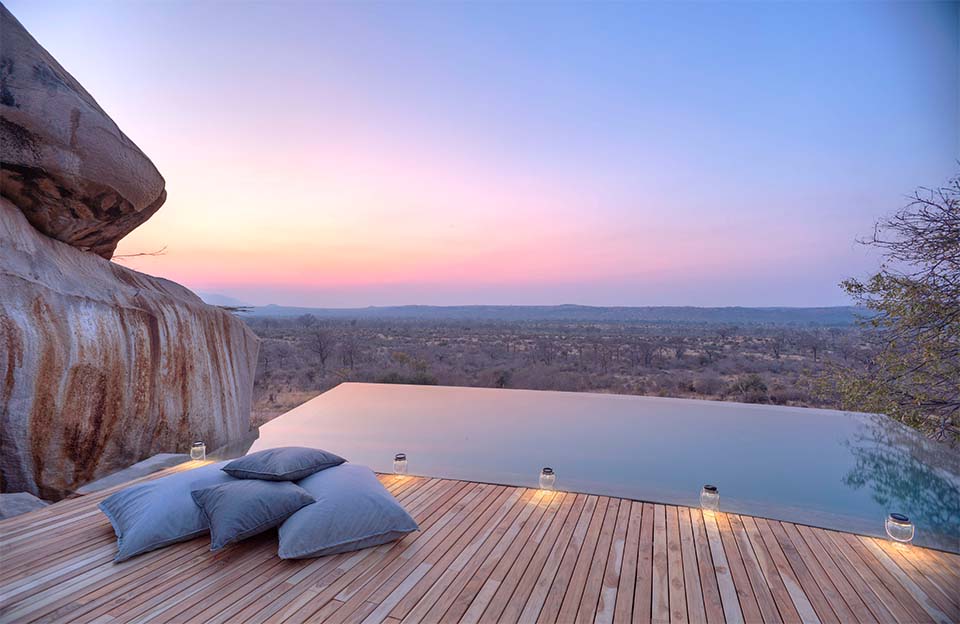Tanzania Countryside, Safari
Safari Goes Luxe on Tanzania’s Southern Circuit


With new luxury lodges and inspiring conservation initiatives, Ruaha National Park is deservedly included in National Geographic’s “Places you need to visit in 2018.” Sue Watt discovers the secret charms of Tanzania’s little visited Southern Circuit.
In the parched afternoon heat, I meet Mr T dozing in the shade with a belly full of buffalo. So called because of a dark T-shaped marking on the back of his mane, this ageing, greying lion still commands respect as the powerful Big Daddy of the Mwagusi Pride, protecting three females and four young cubs. “He’s a real character, a very strong lion,” our guide whispers. “He’ll happily pose for photos but if you step out of line, he lets you know.”
Our encounter with the charismatic Mr T occurs within half an hour of arriving at Ruaha National Park. It’s home to 10% of Africa’s lions, East Africa’s largest population of elephants and several packs of rare wild dogs – quirky canines with saucer-shaped ears and distinctive black, white and gold patterned coats that top my wildlife wish-list. Yet, aside from safari connoisseurs who cherish Ruaha’s secret charms, few visitors come here. With Selous Game Reserve and the smaller parks of Mikumi and Udzungwa, Ruaha forms the country’s little-known Southern Circuit.
Most tourists to Tanzania choose the Northern Circuit featuring the often crowded Ngorongoro Crater and Serengeti. However, discerning travellers are now heading south, lured by pioneering safari operator Asilia Africa. Highly regarded for bringing responsible tourism into less developed regions and supporting conservation and community initiatives, Asilia has recently opened high-end properties in Ruaha and Selous.
Jabali Ridge blends perfectly with Ruaha’s natural environment. Built around huge granite boulders and raised on stilts, the luxury lodge has far-reaching views to Mwagusi River. Its unique design is sophisticated yet soothing, from the subtle pale grey and wood décor of the lounge and dining room to the gin bar, spa and infinity pool. Its eight elegant ensuite rooms and private villa have louvred ‘walls’ that open onto expansive terraces complete with hammocks and huge sofas, ideal for lingering or for starlit dinners.
Wild and remote, Ruaha is Tanzania’s largest national park, spanning 20,000km². With just a handful of lodges, the real luxury here is solitude – it feels as if you have this raw, untrammelled wilderness to yourself. And it’s a beautiful wilderness. Golden sand rivers transform into tumultuous waterways after the rains, and groves of baobabs, skinny palms and acacia are dotted around rolling hills and vast savannahs.
On game drives we rarely encounter other safari vehicles. But we do see huge elephant herds with tiny babies shuffling among them, dazzles of zebras, dainty impalas and gangly giraffes, their legs splayed as they stoop to drink. Greater kudu with swirling horns trot away from us; mink-coloured wildebeest stand and stare. We see jackals and hyena scavenging on buffalo and a leopard almost posing for photos on the bough of a tree. And on a starlit night drive we spot two leopards mating in a brief, unromantic encounter.
Our morning walking safaris, accompanied by an armed ranger, focus on little things, things you don’t get to see, hear, touch or smell on game drives. But we have to be prepared for bigger beasts. “We might come across lions, elephants and hippos,” our guide Tony explains. “If you see them, just stand your ground – and don’t run …”
Ambling quietly along a terracotta-coloured ridge above the river, we check out birds, bugs and plants including a striking red and blue agama lizard and pretty baobab blossom. Suddenly, Tony raises his hand signalling us to stop. “Fresh lion prints, very fresh …” he whispers, looking around. “I love walking safaris,” he continues. “You feel like things are watching you and you don’t know where they are …”
The lion thankfully evades us, yet some 28 prides roam Ruaha’s plains. They’re becoming increasingly vulnerable through conflict with Barabaig and Maasai tribes, who kill them in ancient rituals or to protect their cattle. Fortunately, the Ruaha Carnivore Project, supported by Asilia, is working closely with communities to alleviate both lion and livestock killings. Slowly but surely, it’s transforming traditional cultural attitudes.
The conservation project hopes to expand into Selous Game Reserve, home to the world’s largest lion population. The size of Switzerland, Selous is Africa’s biggest game reserve. It’s a magical, verdant wilderness dominated by the Rufiji River and a chain of lakes that are a magnet for wildlife.
I spend my last day in the Southern Circuit at Asilia’s new camp, Roho ya Selous near the tranquil Lake Nzerakera. Roho exudes understated luxury. Eight vast air-conditioned tents have stylish décor in shades of greens and creams; the airy dining area and lounge afford beautiful lake views from open-sided canvas rooms; and the swimming pool provides welcome relief on hot, humid days.
You’re immersed in nature here: at night, I hear hippos harrumphing and at dawn giraffe wander past my window. On a sunset boat trip, we see masses of crocodiles rouse from their slumber, slithering into the water as we pass. And on my last game drive, we finally find those rare, elusive wild dogs. For two fascinating hours, we watch 23 beautiful canines dozing, playing, hunting, feeding, squealing like children and wallowing in mud. And in true Southern Circuit style, we have them all to ourselves…
Latest Articles
Don't miss the latest from Luxury Travel
